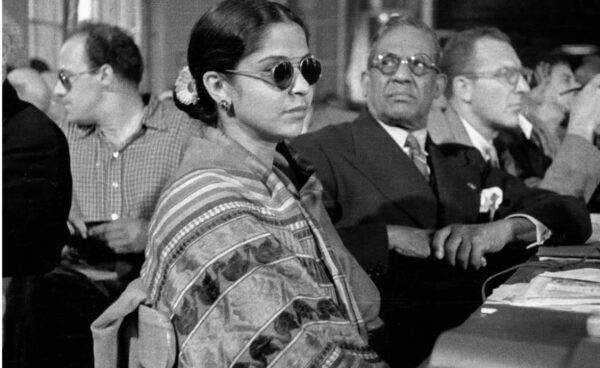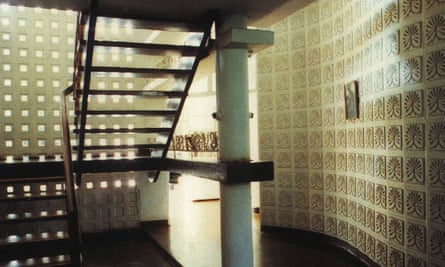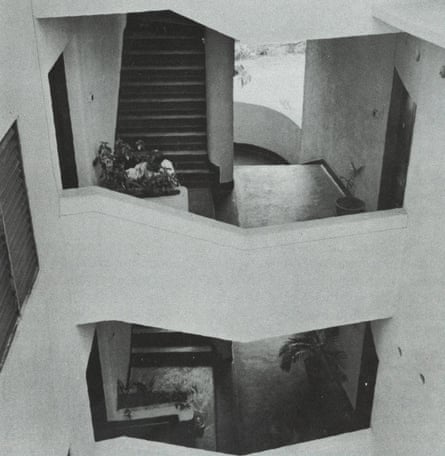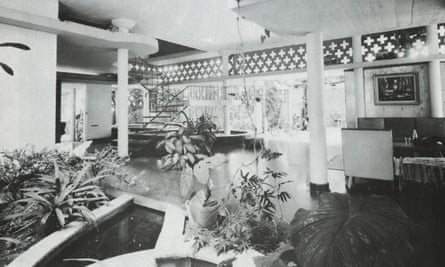Minnette de Silva: the brilliant female architect forgotten by history

Source:Theguardian
Against all odds, the 1940s pioneer of Sri Lankan modernism became one of the world’s most famous women architects. So why are her buildings not celebrated today?
The second house designed by Minnette de Silva, once one of the most famous female architects in the world, stands in Alfred House Gardens, a leafy street in Colombo, Sri Lanka, tucked away from the fumes of nearby Galle Road.
Raised on columns, the house shelters within a limestone boundary wall, its iron gate patterned with leaf shapes. A yellow oleander tree and red bougainvillea spill over the gate, almost entirely obscuring the house that was built for family friends the Pierises in 1952. Inside are De Silva’s trademark features: open courtyards and verandahs alive with trees, shrubs and a pond; a walled garden; a parking space that once doubled as a play area; and a staircase sweeping up to the second floor, where the bedrooms and kitchen are located.
“The bedrooms were one big room divided by teak cupboards,” recalls Prianga Pieris, son of the original owner. “Air flowed freely along the top. As children, we used to talk to each other over the walls.”
His sister, Malkanthi Perera, who lives next door, says: “She had a wonderful sense of using space usefully. Nothing was wasted.” As Perera speaks, the clamour of jackhammers scythes through the leafy canopy. Yet another luxury apartment tower is rearing up, this time behind her house. Colombo is changing at a rapid pace: the population is now about 6 million, and high-rise blocks are encroaching on the elegant villas of Alfred House Gardens. De Silva’s house is one of few that remain.

The daughter of a reformist politician and suffragette, and a close friend of the architectural giant Le Corbusier, Minnette de Silva was Sri Lanka’s first modernist architect and the first Asian woman to become an Associate of the Royal Institute of British Architects.
She pursued her vocation despite her father’s opposition, moving first to Mumbai and later postwar London to study. During her time at the Architectural Association (AA) in the UK she cut an elegant figure, draped in silk saris and followed by a train of young male students bearing her bags and instruments.

She exploited her difference – her exotic appearance and unique position at the AA – to launch herself into high society. Within no time, she became a 1940s “It girl”, rubbing shoulders not just with Le Corbusier but also Henri Cartier-Bresson, Picasso and Laurence Olivier. She never married, confiding much later in life to a friend that husbands were only good for carrying one’s bags.
After Sri Lanka became independent in 1948, De Silva returned and set up a studio in her family home at St George’s – one of only two women in the world at the time to establish an architectural practice in her own name.
From there she began designing and building everything from cottages to villas to entire apartment blocks. Her trademark was to develop modernist architecture in harmony with the landscape and traditional craftsmanship.

The Pieris’ house, her first building in Colombo, bore those unmistakeable marks: striped, lacquered balusters in maroon and gold leaf print, echoing traditional Kandyan craftwork; doors inset with woven palm panels bearing a simple tile pattern in similar colours.
Although born into a wealthy family and an undeniable member of the global elite, she was concerned with more than just building houses for her friends. Her attempt to fuse artisanal traditions with her modernist buildings ensured that often impoverished craftspeople could earn a living from their work.
In the 1950s she worked on a housing development scheme for public servants in Kandy, the island’s second largest city. The scheme was groundbreaking: De Silva consulted extensively with future householders to find out how they wanted to live – information she then used to design different housing types, some of which were built by the householders themselves. It was a participatory approach that was decades ahead of its time.
She experimented with indigenous methods such as wattle and daub, and incorporated rammed earth technology – a process popularly used for today’s ecohomes – into buildings such as the townhouse, built for Mrs CF Fernando.
Located a little further south in Colombo, the Fernando townhouse was the product of her research into cost-effective builds. In a 1955 article, De Silva wrote: “We must re-orientate our ideas for living comfortably in congested towns like Colombo, where we no longer have expansive acres of garden and spacious cool pillared halls …”

De Silva’s Pererea House, Colombo 1957. Photograph: LASWA
The Fernando house is a compact cube, with cooling crosswinds channelled through a central staircase and surrounding verandahs, and air shafts between the door lintels and the ceiling. In a city where temperatures regularly surpass 30C (86F) in 90% humidity, such measures are crucial.
“She was a very nice, intelligent lady,” says Fernando, who still lives in the house. As we speak at her dining table the nearby staircase, constructed from inexpensive but brilliantly polished satinwood, seems to spill sunlight down into the room. “She had done a lot of improvements in building and trying to cut down expenses. She was very cooperative.”
For all De Silva’s vision, her contribution to architecture has been only belatedly – and sometimes begrudgingly – acknowledged. It is Geoffrey Bawa whose work is usually quoted as pioneering in Sri Lanka, even though De Silva preceded him by a decade. As the writer and architect David Robson has pointed out, it was De Silva’s experiments in fusing European modernism and a regional style of architecture that made it possible for Bawa to create the masterpieces for which he is celebrated.
As a woman, her ideas were often questioned by clients, even her own contractor. While building the Pieris’ house, she was forced to have her design endorsed by an engineer in London before her contractor agreed to build it. “It was male chauvinism at its best,” observes C Anjalendran, an architect once closely associated with Bawa and De Silva.
These setbacks toughened her demeanour. “It was very unusual to see a woman in that kind of occupation,” says Charith, Fernando’s son. “She was very assertive – she was able to get round the workmen. She wouldn’t stand for any nonsense.”
It wasn’t enough. Her toughness soon gave her a reputation for being a “difficult woman”. Following an intense period of building in the 1950s, De Silva’s contracts dried up, while Bawa’s rocketed. Ismeth Raheem, an architect who worked closely with Bawa in the early years, recalls De Silva telling him on several occasions: “I was dismissed because I am a woman. I was never taken seriously for my work.”
“At the time, being a woman in a man’s profession in a developing country was really almost impossible,” says Anjalendran. “Also, as a woman, she was expecting to be paid!”
In 1996, the Sri Lanka Institute of Architects awarded De Silva the gold medal – 14 years after it recognised Bawa. By then De Silva was in financial straits, marginalised and isolated. Two years later she died alone in a hospital in Kandy, after falling from the bathtub, where she lay for days before she was found. She was 80.

In the 20 years since her death, her studio and home in Kandy have fallen into ruin. It is not the only one. Many of De Silva’s surviving works are in a precarious state. Her first build, a low-slung villa that clings to the side of a hill in Kandy, is in danger of being demolished by its current owners. The Fernando townhouse, although largely intact, probably remains standing only because Mrs Fernando is still alive.
Will there be a revival of De Silva’s work? During his time teaching at the City School of Architecture in the late 1980s, Anjalendran ensured her work was included in the curriculum so her contribution would be remembered. Anjalendran visited her often in her later years and recalls a troubled soul: “Nobody went to talk to her – you didn’t have an escape route. She made herself lonely.” Indeed, there are few signs that she is in any way beloved in Sri Lanka.
But look closely at some of Colombo’s more progressive architecture and you can see her influence. It’s there in the expansive Kandyan-styled roofs of Sri Lanka’s parliament complex, or the presence of indoor garden spaces inviting a piece of open sky into living rooms across the city.

The ubiquity of handwoven textiles, lacquerware and brasswork as key design features in everything from boutique hotels to middle-class flats has also sprung from the same well of ideas. Back in the 1950s those ideas were radical, more so because they were applied to both rich and poor.
They are radical again now that they are under such direct threat. Sri Lanka, until recently torn apart by civil war, is in a state of near-continuous reconstruction. Ambitious development projects are afoot in many of its cities. The latest, Port City Colombo, promises luxury tower blocks on reclaimed land reminiscent of the Palm Jumeirah in Dubai.
“She would have hated it,” says Selva Sandrapragas, a British architect who worked with De Silva in her later years. “It displays no sensitivity to the history, culture or geography of where it is. It wraps itself around the old city, destroying the former context, suffocating it from the sea. It could literally be anywhere: Singapore, Dubai, Hong Kong.”
Shiromi Pinto’s novel based on Minnette de Silva’s life, Plastic Emotions, will be published by Influx Press in summer 2019. She can be found of Twitter as @blimundaseyes
Follow Guardian Cities on Twitter, Facebook and Instagram to join the discussion, and explore our archive here
… we have a small favour to ask. Millions are turning to the Guardian for open, independent, quality news every day, and readers in 180 countries around the world now support us financially.
We believe everyone deserves access to information that’s grounded in science and truth, and analysis rooted in authority and integrity. That’s why we made a different choice: to keep our reporting open for all readers, regardless of where they live or what they can afford to pay. This means more people can be better informed, united, and inspired to take meaningful action.
In these perilous times, a truth-seeking global news organisation like the Guardian is essential. We have no shareholders or billionaire owner, meaning our journalism is free from commercial and political influence – this makes us different. When it’s never been more important, our independence allows us to fearlessly investigate, challenge and expose those in power. Support the Guardian from as little as $1 – it only takes a minute. If you can, please consider supporting us with a regular amount each month. Thank you.




















